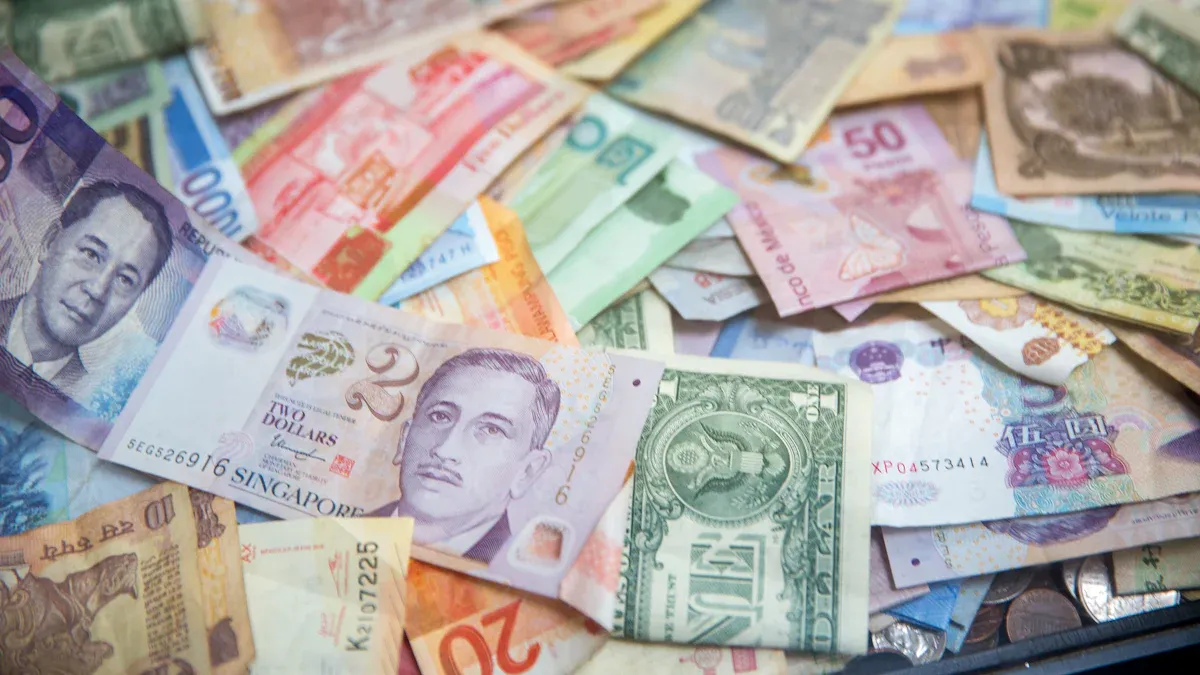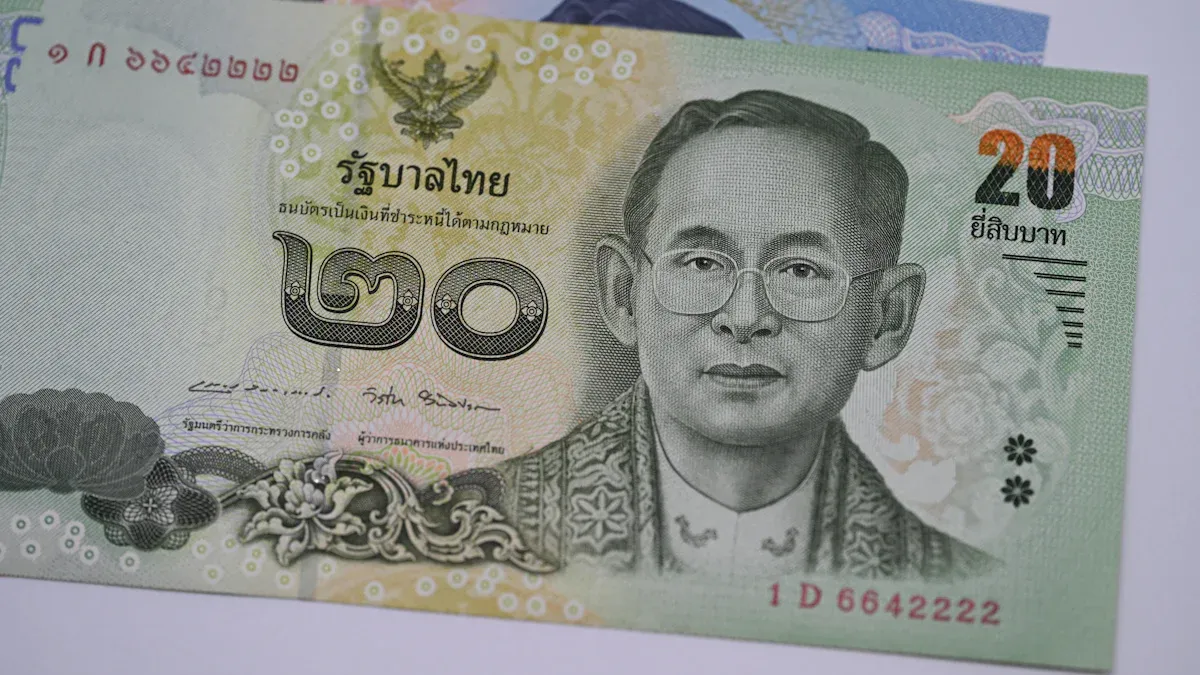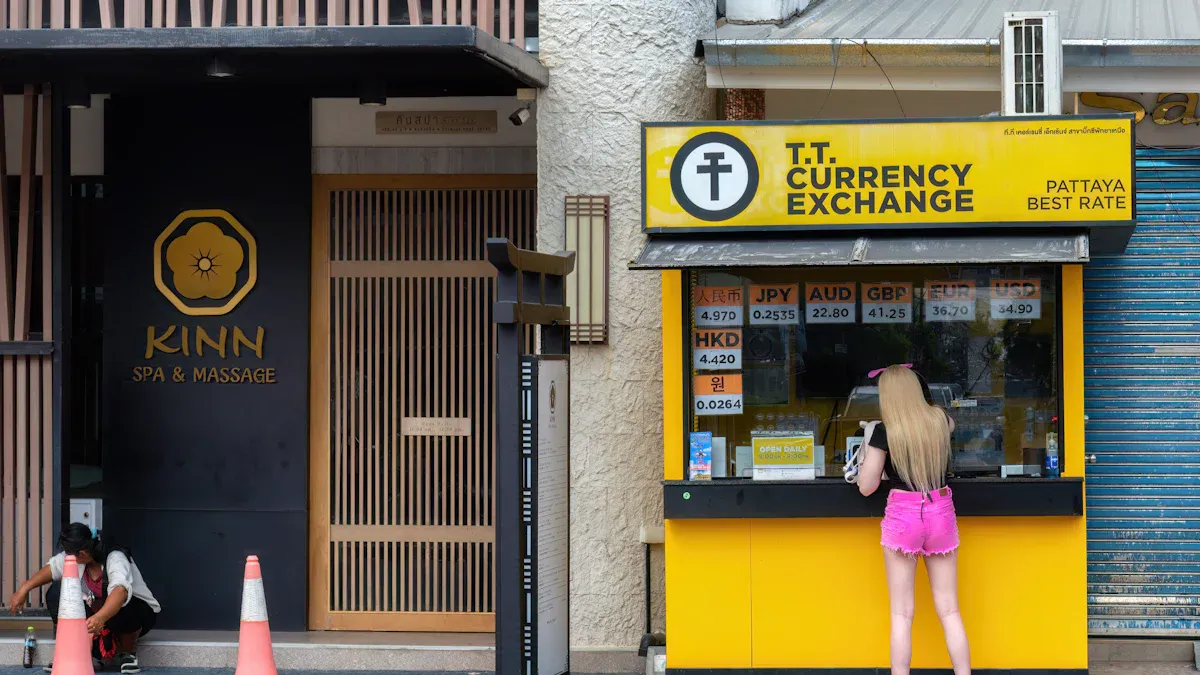- EasyCard
- Trade
- Help
- Announcement
- Academy
- SWIFT Code
- Iban Number
- Referral
- Customer Service
- Blog
- Creator
What Is the Thai Baht and How Is It Used

Image Source: unsplash
You will use the Thai baht when you travel in Thailand. The baht, with the symbol ฿ and code THB, serves as the only currency for shopping, eating, and paying for services. Most places in Thailand accept only baht, so you need to know how to handle this money. When you exchange travel money, keep in mind that 1 baht equals about 0.0306 USD. The table below shows how the Thai baht compares to major world currencies:
| Currency | Exchange Rate (per 1 unit) |
|---|---|
| Thai Baht (THB) to US Dollar (USD) | 0.0306 USD |
| US Dollar (USD) to Thai Baht (THB) | 32.6751 THB |
| US Dollar (USD) to Euro (EUR) | 0.8734 EUR |
| Euro (EUR) to US Dollar (USD) | 1.1449 USD |
You will find that understanding baht helps you manage your money and enjoy your travel in Thailand.
Key Takeaways
- The Thai baht (฿, THB) is the only currency accepted for everyday purchases in Thailand, so always use baht for shopping, dining, and services.
- Carry enough baht in small bills and coins, especially for street vendors, markets, and rural areas where cards are not accepted.
- Use licensed banks or authorized exchange booths for currency exchange to get the best rates and avoid scams; avoid airport counters and street vendors.
- ATMs are common in cities and tourist spots but may be scarce in rural areas; plan ahead and keep your ATM receipts for security.
- Keep your money safe by using hotel safes, carrying small amounts of cash, staying alert in crowded places, and watching out for common scams.
Thai Baht Overview
Official Currency in Thailand
You will use the Thai baht as the official currency in Thailand. This national currency carries the symbol ฿ and the code THB. The Thai baht is the only legal currency accepted for payments in Thailand. You cannot use foreign currencies for shopping, eating, or paying for services. Thai law requires you to conduct all transactions in baht, and strict rules control the use of other currencies. If you receive large amounts of foreign currency, you must convert it into Thai baht within a set period. Merchants who claim to accept other currencies often give poor exchange rates, so you should always use baht for the best value. Both coins and banknotes show the image of the Thai King, which highlights the baht’s official status.
Note: The Thai baht is the only currency you can use for everyday transactions in Thailand. You will see coins and banknotes in many denominations, from small satang coins to large 1,000 baht bills.
Bank of Thailand and Issuance
The Bank of Thailand serves as the sole issuer and regulator of the Thai baht. This central bank controls the supply and stability of the currency. You will find that the Bank of Thailand takes steps to protect the value of the baht, especially as new digital forms of money appear. The bank treats baht-pegged stablecoins as electronic money and requires companies to consult with the Bank of Thailand before launching such products. The Bank of Thailand also sets rules to prevent risks to the financial system, such as anti-money laundering and cybersecurity measures. The bank is developing its own digital version of the baht to give you a safe and efficient way to use the currency in the future. These actions help keep the Thai baht stable and secure for everyone in Thailand.
If you look at the history of the Thai baht, you will see how it became the official currency in Thailand:
- Early forms of currency in Thailand included shells, baked clay coins, and pot duang before the introduction of flat banknotes and coins.
- In 1853, King Mongkut introduced the first paper money called Mai, but people did not widely accept it.
- During King Chulalongkorn’s reign starting in 1873, a shortage of copper coins led to the use of low-value paper currency called Att Kradat.
- Between 1889 and 1899, foreign commercial banks received permission to issue banknotes to help trade and economic growth.
- Plans for government-issued Treasury Notes in 1890 did not succeed because of management problems.
- In 1902, the Thai Department of Technology under the Ministry of Finance began issuing modern Thai banknotes, which started to circulate on September 23, 1902.
Subdivisions and Satang
You will notice that the Thai baht is divided into 100 satang. This system works much like cents in the United States. The satang acts as the fractional unit of the baht. When you pay for goods or services in Thailand, you may see prices listed with satang, but most transactions round to the nearest baht. You will find satang coins in small denominations, but you may not use them often in daily life. The baht remains the main unit for most purchases, making it easy for you to handle money during your stay in Thailand.
Denominations and Features

Image Source: pexels
Banknotes
You will see several banknote denominations when you use the thai baht in Thailand. The most common notes are 20, 50, 100, 500, and 1,000 baht. The Bank of Thailand started issuing the 17th series of these notes in 2018. In 2022, the 20 baht note changed to a polymer material, making it more durable. Each note has a different color, which helps you identify them quickly. You will use these notes for shopping, dining, and paying for services. The table below shows the current banknotes in circulation:
| Denomination | Color | Common Use |
|---|---|---|
| 20 baht | Green | Small purchases, transport |
| 50 baht | Blue | Meals, groceries |
| 100 baht | Red | Shopping, restaurants |
| 500 baht | Purple | Larger expenses |
| 1,000 baht | Brown | Hotels, electronics |
Coins
You will also use coins for many daily transactions. The thai baht coins come in 1, 2, 5, and 10 baht values. You may also find satang coins, but most people use baht coins for convenience. Coins work well for street food, public transportation, and small shops. The table below lists the coins you will find in Thailand:
| Denomination | Material/Color | Typical Use |
|---|---|---|
| 1 baht | Silver | Snacks, vending machines |
| 2 baht | Gold | Fares, small items |
| 5 baht | Silver | Market purchases |
| 10 baht | Bimetallic | BTS/MRT tickets, change |
Note: 1 baht equals 100 satang. You may see prices with satang, but most shops round to the nearest baht.
Design and Security
The design of thai baht notes and coins reflects Thai culture and history. You will notice images of the Thai King and important national symbols on each note and coin. The Bank of Thailand uses advanced security features to protect the baht from counterfeiting. These features include watermarks, animated 3D magnetic ink, color-changing ink, and special inks that glow under ultraviolet light. These elements make the notes both attractive and secure. When you handle thai baht, you can feel confident that the currency is safe and reliable.
Using Money in Thailand
Everyday Transactions
You will use the baht for almost every purchase in Thailand. Most shops, restaurants, and service providers accept only the local currency. Foreign currencies are rarely used for daily spending. When you visit street food vendors, local markets, or small stores, you will need cash. Many tuk-tuks, taxis (if not booked through an app), museums, galleries, temples, and public transport also require cash payments. In smaller towns and rural areas, cash is essential because many sellers do not accept cards. You should also use cash for tipping service workers and hotel staff. PromptPay QR payments are growing in popularity, but cash remains necessary for small payments and tips.
Tip: Always carry enough baht in small denominations. Many local sellers may not have change for large bills.
Here are some places where cash is preferred:
- Street food vendors
- Local markets
- Small stores
- Tuk-tuks and taxis (not booked via apps)
- Museums, galleries, and temples
- Public transport
- Rural areas and smaller towns
- Tipping service workers
Cash vs Card
In Thailand, you will find that cards are widely accepted in large businesses, hotels, and restaurants in bigger cities. Supermarkets and retail malls also accept credit and debit cards. In urban areas and popular tourist destinations, you can often pay with a card. However, many smaller businesses and local sellers do not accept cards. Cash remains the preferred payment method in rural areas and local marketplaces. You may see contactless payments and PromptPay QR codes in some places, but these options are not universal outside major cities.
The table below shows where you can use cash or cards:
| Type of Establishment | Cash Needed | Card Accepted |
|---|---|---|
| Street food vendors | ✔️ | ✖️ |
| Local markets | ✔️ | ✖️ |
| Small shops | ✔️ | ✖️ |
| Hotels (big cities) | ✖️ | ✔️ |
| Restaurants (big cities) | ✖️ | ✔️ |
| Supermarkets | ✖️ | ✔️ |
| Public transport | ✔️ | ✖️ |
| Rural areas | ✔️ | ✖️ |
You should always carry some baht for places that do not accept cards. This will help you avoid problems when paying for goods or services.
ATMs and Withdrawals
ATMs in Thailand are very common in urban areas. You will find them at bank branches, street corners, major convenience stores like 7-Eleven, shopping malls, and airports. These machines let you withdraw baht using your international debit or credit card. In cities and tourist areas, you can access ATMs easily. However, rural areas and some lesser-known islands have limited or no ATM availability. If you plan to visit these places, you should withdraw enough cash in advance.
While ATMs are widespread in cities, the fees for withdrawing money can vary. AEON Bank ATMs usually offer the lowest fees, but they are not as common as other machines. You should check the withdrawal fees before using an ATM. Always use ATMs attached to banks or inside shopping centers for better security.
Note: Always keep your ATM receipts and check your balance after each withdrawal. If you lose your card, contact your bank immediately.
You will need to use baht for most transactions in Thailand. ATMs in Thailand make it easy to get local currency, but you should plan ahead if you travel to rural areas. Carrying enough cash will help you avoid problems when you cannot find an ATM.
Exchange Currency in Thailand

Image Source: pexels
Where to Exchange
You have many options when you want to exchange currency in Thailand. The best place to exchange money is usually at banks or authorized exchange booths in city centers. These places include well-known names like SuperRich, Value Plus, and SIA Exchange. They display daily rates and have clear business licenses. You can trust these counters to give you fair deals and safe service. Airports also offer exchange services, but their rates are often 10-15% worse than market rates and may include hidden fees. You should only exchange a small amount at the airport for immediate needs, such as transportation or snacks.
- Banks and authorized booths in cities offer the best rates.
- Airport counters are convenient but cost more.
- Always look for booths with clear licenses and posted rates.
Getting the Best Rates
To get the best rates, bring major currencies like US dollars or British pounds when you travel. These currencies are easy to exchange and often get better rates than less common ones. Before you buy Thai baht, compare the currency exchange rate at different booths. Even booths close to each other can offer different rates. Reliable sources like CurrencyRate.Today help you check live rates from banks such as Siam Bank, CIMB Thai, and Bank of America. This site updates rates every hour and shows trends, so you can plan when to exchange for the best value.
Tip: Check the latest rates online before exchanging Thai baht. This helps you avoid overpaying.
What to Avoid
You should avoid scams when exchanging currency. Never exchange money with street vendors or unofficial counters. These places may offer poor rates or even fake notes. Always use licensed booths or banks. Watch out for hidden fees, especially at airports. If a rate looks too good to be true, it probably is. Compare rates and ask about extra charges before you exchange. This way, you protect your money and get the best rates.
Money Safety Tips
Keeping Money Safe
You can keep your money and valuables secure by following a few simple steps. Use sturdy travel locks on your luggage to prevent unauthorized access. Store your passport, cash, and electronics in the hotel safe whenever possible. Carry only the cash you need for the day and leave the rest in a secure place. Keep important documents in waterproof pouches to protect them from rain or spills. Stay alert in crowded places, as bag snatching and pickpocketing can happen. Always know how to contact local tourist police or Thai police in case of emergencies. These habits help you avoid loss and enjoy your trip with peace of mind.
- Use travel locks on your bags.
- Store valuables in hotel safes.
- Carry small amounts of cash.
- Protect documents in waterproof pouches.
- Stay aware of your surroundings.
- Know emergency contact numbers.
Avoiding Scams
You may encounter scams targeting travelers in Thailand. Tuk-tuk and taxi drivers sometimes refuse to use meters or take you to shops where they earn commissions. Always agree on the fare before you ride and insist on using the meter. Some people may approach you on the street and offer deals that seem too good to be true. Politely decline and walk away. When renting jet skis or motorbikes, take photos of the vehicle before use and rent only from reputable shops. Use ATMs located at bank branches and check for any unusual devices on the machine to avoid card skimming. Keep your valuables with you on overnight buses to prevent theft.
- Agree on fares before riding tuk-tuks or taxis.
- Insist on meter use or use ride-hailing apps.
- Avoid unsolicited offers from strangers.
- Take photos of rental vehicles before use.
- Use ATMs at bank branches and inspect machines.
- Keep valuables in your carry-on during bus trips.
Smart Spending
You can manage your budget in Thailand by planning your expenses. Book flights early and compare prices using travel websites. Choose hostels or guesthouses for affordable stays. Buy a local SIM card for cheaper internet access. Eat at street food stalls to enjoy delicious meals at low prices. Shop at local markets for bargains and unique items. Avoid expensive Western food and alcohol to keep your costs down. Use apps like GRAB for taxis with clear pricing. Plan your activities and set a daily spending limit to avoid overspending.
| Budget Category | Strategy / Tip | Approximate Cost (USD) |
|---|---|---|
| Flights | Book early, compare prices | $500–$800 |
| Accommodation | Choose hostels or guesthouses | $5–$20 per night |
| Food & Drink | Eat street food, avoid Western food and alcohol | Street food: very affordable |
| Transport | Use apps for taxis, book buses early | Taxi: $4–$15; Bus: $35–$40 |
| Activities | Rent bikes, join affordable tours | Bike: $4/day; Tours: varies |
By following these tips, you can keep your money safe, avoid scams, and make the most of your travel budget in Thailand.
Understanding the Thai baht helps you manage your money and avoid problems during your trip. You can make better choices and feel more confident when you know how to use cash, cards, and ATMs.
- You avoid poor exchange rates by using licensed counters and comparing rates.
- You keep your money safe by counting it in front of staff and saving receipts.
- You carry cash for small purchases and use cards for bigger expenses.
- You watch out for scams and only use trusted places to exchange money.
When you learn about the Thai baht, you enjoy a smoother and safer travel experience in Thailand.
FAQ
Can you use US dollars or other foreign currencies in Thailand?
You cannot use US dollars or other foreign currencies for daily purchases in Thailand. Shops and restaurants accept only Thai baht. You should exchange your money for baht at a licensed exchange booth or bank. Check current exchange rates here.
What is the best way to get Thai baht in Thailand?
You can withdraw baht from ATMs using your international card. You can also exchange cash at banks or authorized exchange booths. ATMs charge a fee, usually around $6 per withdrawal. Compare rates before exchanging money for the best value.
Are credit cards widely accepted in Thailand?
You can use credit cards in hotels, large restaurants, and shopping malls in big cities. Many small shops, markets, and street vendors accept only cash. Always carry some baht for places that do not take cards.
How can you spot fake Thai baht notes?
You can check for security features like watermarks, color-changing ink, and raised printing. Hold the note up to the light to see the watermark. If you feel unsure, compare the note to another of the same value.
Navigating a new country’s currency can be a challenge, as this article on the Thai Baht makes clear. While the Thai baht is essential for local spending, travelers and international residents often face the complexities of currency exchange, from unfavorable rates at airports to high fees for ATM withdrawals. This is where a modern financial solution like BiyaPay offers a seamless and cost-effective alternative. Our platform simplifies your global transactions, providing real-time exchange rate queries and conversions for various fiat and digital currencies with remittance fees as low as 0.5%.
Whether you’re a digital nomad, a frequent traveler, or a business owner dealing with international payments, BiyaPay makes it easy to manage your money across borders. Our service supports money transfers to most countries and regions worldwide, ensuring your funds get where they need to go quickly—often on the same day. Don’t let unfavorable exchange rates and hidden fees hold you back. Use our Real-time Exchange Rate Calculator to see how much you can save, and get started with a single app that meets all your international financial needs. Register now and experience a new level of financial freedom.
*This article is provided for general information purposes and does not constitute legal, tax or other professional advice from BiyaPay or its subsidiaries and its affiliates, and it is not intended as a substitute for obtaining advice from a financial advisor or any other professional.
We make no representations, warranties or warranties, express or implied, as to the accuracy, completeness or timeliness of the contents of this publication.




Contact Us
Company and Team
BiyaPay Products
Customer Services
is a broker-dealer registered with the U.S. Securities and Exchange Commission (SEC) (No.: 802-127417), member of the Financial Industry Regulatory Authority (FINRA) (CRD: 325027), member of the Securities Investor Protection Corporation (SIPC), and regulated by FINRA and SEC.
registered with the US Financial Crimes Enforcement Network (FinCEN), as a Money Services Business (MSB), registration number: 31000218637349, and regulated by FinCEN.
registered as Financial Service Provider (FSP number: FSP1007221) in New Zealand, and is a member of the Financial Dispute Resolution Scheme, a New Zealand independent dispute resolution service provider.




















